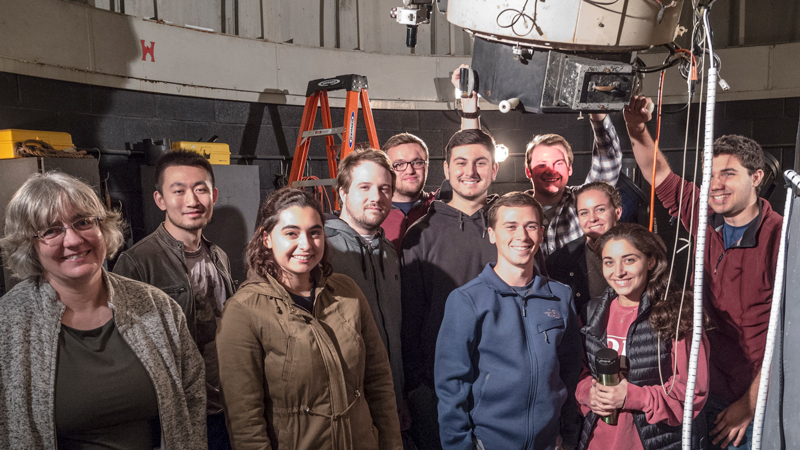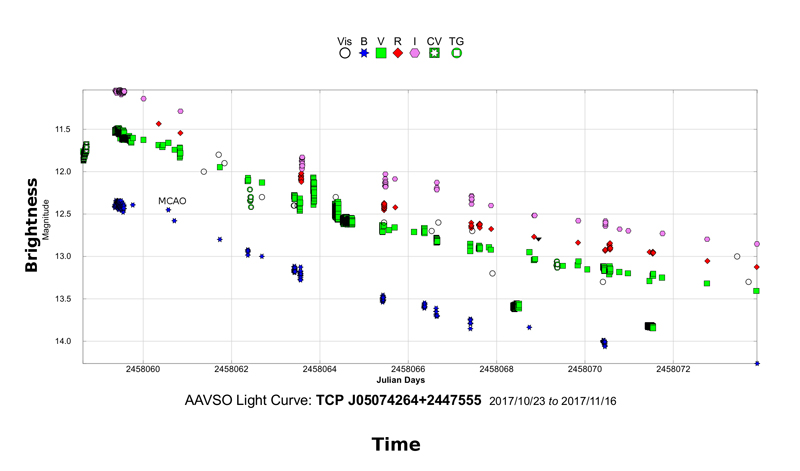


A rare glimpse of astronomical phenomenon
Photo by Beth Miller; stars photo courtesy of Prof. Judi Provencal November 29, 2017
Astronomer and students observe gravitational microlensing from Mt. Cuba Observatory
To Hannaleigh Scott, it looked like someone had spilled salt all over a dark tablecloth - just the way any starry night might appear to a casual observer.
But this was no ordinary star census. And one of those dots was not like the others.
Indeed, University of Delaware astronomer Judi Provencal and her students got a rare glimpse of gravitational microlensing earlier this month at the Mt. Cuba Astronomical Observatory, where they study the night sky using instruments designed to observe and measure the mysteries of the universe.
Gravitational microlensing is a phenomenon - described by Albert Einstein in 1915 and first observed in 1979 - that gives astronomers insight into far-distant objects because of the way light interacts with space and the objects in space.
"It's sort of like a warp field on 'Star Trek,' in that mass bends and warps its surrounding space," Provencal said. "Light rays from objects more distant than the massive object will follow curved paths, creating brighter images."

The phenomenon allows astronomers to learn about distant objects they might not otherwise detect, because those objects do not radiate much - if any - light. When such an object comes between Earth and a distant star it changes the direction of the light from the star. We see the star mysteriously brighten. This "microlensing event" signals the presence of an unseen object.
The background star appears to brighten because the light rays that usually are dispersed throughout the sky are instead pulled together by the gravitational pull of that dark object, with more of the light directed toward Earth.
Provencal's colleague in the department of physics and astronomy, Associate Professor Sally Dodson-Robinson, specializes in planet formation and said microlens events can help researchers with their calculations.
"It's taking that light that was going in all directions and beaming it at us," Dodson-Robinson said. "How much the background star brightens tells you something about the mass of the planet and the orbit of the planet."
The Whole Earth Telescope network, a Delaware-based collaboration of more than 40 observatories on six continents, is part of the global follow-up study of this event. Provencal directs the Whole Earth Telescope project.
"A whole network of astronomers has been staring at these stars that are very far away," Dodson-Robinson said. "They stare at the center of the galaxy because a lot of stars are packed into a small space there. That's important because microlensings are rare, so you have to look at a lot of stars to find one. And when they see something, they alert all these astronomers around the world."
That allows astronomers to gather data 24 hours a day. Microlens events can be quite brief - a few hours, a few days, a month - so it helps to have many eyes at work.
When Provencal heard about this event - first observed Oct. 31 by Tadashi Kojima of Gunma-ken, Japan - she wanted her students to have a chance to see it, too.
Earlier this month, they did. The microlensing event occurred within the constellation Taurus. The distant star involved has a somewhat obscure name - TCPJ05074264+2447555.
Provencal was able to photograph it using a series of 20-second exposures through different filters and she uploaded their observations to the American Association of Variable Star Observers (AAVSO). (For those who wish to explore AAVSO's collection of data, AAVSO has tagged the distant star with a shorter name - 000-BML-703.

"An isolated one like this is kind of hard to find," Provencal said. "It probably happens a lot, but it is hard to find.... It is the first one I have ever seen."
That puts a different shine on such work, as Provencal has been an astronomer almost 30 years. And astronomers now believe the "dark object" may be more than one object - an exciting prospect indeed, Provencal said.
What first looked like so much spilled salt "feels very special now," said Scott, who is majoring in mechanical engineering.
Much remains unknown about planetary formation, dark matter and other astronomical phenomena.
"And there is a lot of room for error in these calculations," Dodson-Robinson said. "Einstein's equations can have multiple solutions for the same set of observations. But you can get some idea. And if you get lucky and the microlens is in a particular geometry, sometimes you get an actual answer."
The quest to understand continues.
"Dark matter is still weird," Provencal said. "It's weird because we don't know much about it. But that's what makes astronomy fun - what we don't know."
Contact Us
Have a UDaily story idea?
Contact us at ocm@udel.edu
Members of the press
Contact us at mediarelations@udel.edu or visit the Media Relations website

